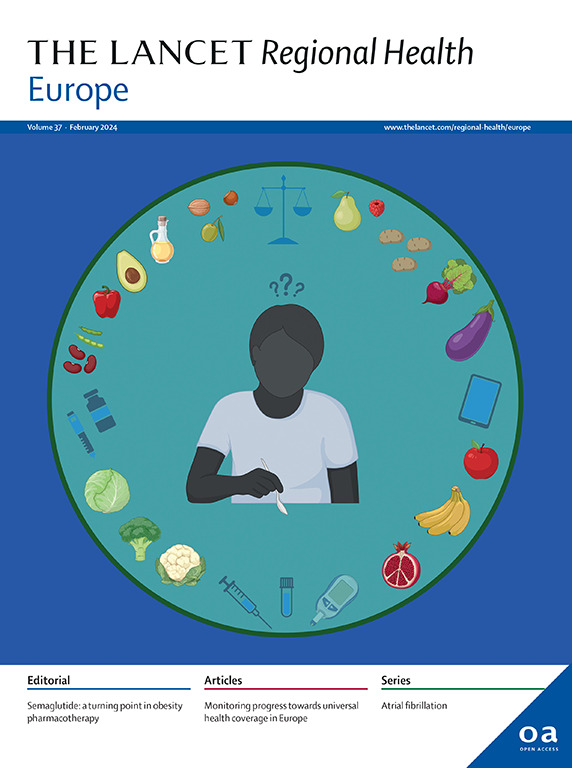根据社会经济地位,有和无精神障碍个体的病因特异性死亡率:一项基于人群的队列研究
IF 13
Q1 HEALTH CARE SCIENCES & SERVICES
引用次数: 0
摘要
精神障碍与特定病因死亡率升高有关;然而,社会经济地位(SEP)在这些关联中的作用尚不清楚。我们的目的是通过SEP在相对和绝对尺度上检查与不同精神障碍相关的病因特异性死亡率。方法本队列研究纳入2000年1月1日丹麦所有居民,随访至2020年12月31日。有关精神障碍、SEP(收入百分位数,进一步分为低[<;20%]、中[20-79%]和高[≥80%])和死因特异性死亡率的信息来自全国登记。我们用泊松回归模型估计死亡率比(MRRs)和死亡率差(MRDs)。总体而言,5,316,626人(50.6%为女性,中位年龄38.3岁)随访21年。精神障碍患者(与无精神障碍患者相比)在所有11种特定死亡原因中都有更高的死亡率,与SEP无关。在所有11种死亡原因中,低SEP组与无精神障碍患者的mrd(每10,000人年)均大于高SEP组,除了自杀,高SEP组的mrd最大(中等SEP组为9.3 [95% CI 8.6-9.9],中等SEP组为7.2[6.0 - 7.5],低SEP组为6.1[5.8-6.4])。对于大多数原因,SEP组的mrr相似,癌症相关死亡增加30-40%,其他原因特异性死亡增加两倍以上。相反,高sep组死于酒精滥用和自杀的相对风险(MRRs分别为10.9 [95% CI 9.9-12.0]和17.7[16.0-19.6])高于中等sep组(8.3[8.0-8.6]和11.1[10.6-11.7])或低sep组(4.8[4.6-5.0]和7.9[7.3-8.6])。所有亚组、敏感性和事后分析都显示出相似的模式。我们通过SEP提供了与特定精神障碍相关的病因特异性死亡率的详细描述,并揭示了SEP在死亡原因中的潜在差异作用。丹麦独立研究基金。本文章由计算机程序翻译,如有差异,请以英文原文为准。
Cause-specific mortality in individuals with and without mental disorders according to socioeconomic position: a population-based cohort study
Background
Mental disorders are associated with elevated cause-specific mortality rates; however, the role of socioeconomic position (SEP) on these associations remains unclear. We aimed to examine cause-specific mortality associated with diverse mental disorders by SEP, on both relative and absolute scales.
Methods
This cohort study included all residents of Denmark on January 1, 2000, and followed them until December 31, 2020. Information on mental disorders, SEP (income percentile, further categorized into low [<20%], middle [20–79%], and high [≥80%]), and cause-specific mortality was obtained from nationwide registers. We estimated mortality rate ratios (MRRs) and rate differences (MRDs) with Poisson regression models.
Findings
Overall, 5,316,626 individuals (50.6% females, median age 38.3 years) were followed up to 21 years. People with mental disorders (versus without) experienced higher mortality rates from all 11 specific causes of death, regardless of SEP. MRDs (per 10,000 person-years) between people with versus without mental disorders were greater in the lower than the higher SEP groups for all 11 causes of death, except suicide where MRDs were largest in the high-SEP group (9.3 [95% CI 8.6–9.9] versus 7.2 [7.0–7.5] in middle- and 6.1 [5.8–6.4] in low-SEP groups). MRRs were similar across SEP groups for most causes, with a 30–40% increase for cancer-related deaths, and more than two-fold increase for other cause-specific deaths. Conversely, relative risks of dying from alcohol misuse and suicide were higher among the high-SEP groups (MRRs: 10.9 [95% CI 9.9–12.0] and 17.7 [16.0–19.6] respectively) than the middle-SEP (8.3 [8.0–8.6] and 11.1 [10.6–11.7]) or low-SEP (4.8 [4.6–5.0] and 7.9 [7.3–8.6]) groups. All subgroup, sensitivity, and post-hoc analyses indicated similar patterns.
Interpretation
We provide detailed descriptions of cause-specific mortality associated with specific mental disorders by SEP and reveal potentially differential roles of SEP across causes of death.
Funding
Independent Research Fund Denmark.
求助全文
通过发布文献求助,成功后即可免费获取论文全文。
去求助
来源期刊

Lancet Regional Health-Europe
Multiple-
CiteScore
19.90
自引率
1.40%
发文量
260
审稿时长
9 weeks
期刊介绍:
The Lancet Regional Health – Europe, a gold open access journal, is part of The Lancet's global effort to promote healthcare quality and accessibility worldwide. It focuses on advancing clinical practice and health policy in the European region to enhance health outcomes. The journal publishes high-quality original research advocating changes in clinical practice and health policy. It also includes reviews, commentaries, and opinion pieces on regional health topics, such as infection and disease prevention, healthy aging, and reducing health disparities.
 求助内容:
求助内容: 应助结果提醒方式:
应助结果提醒方式:


